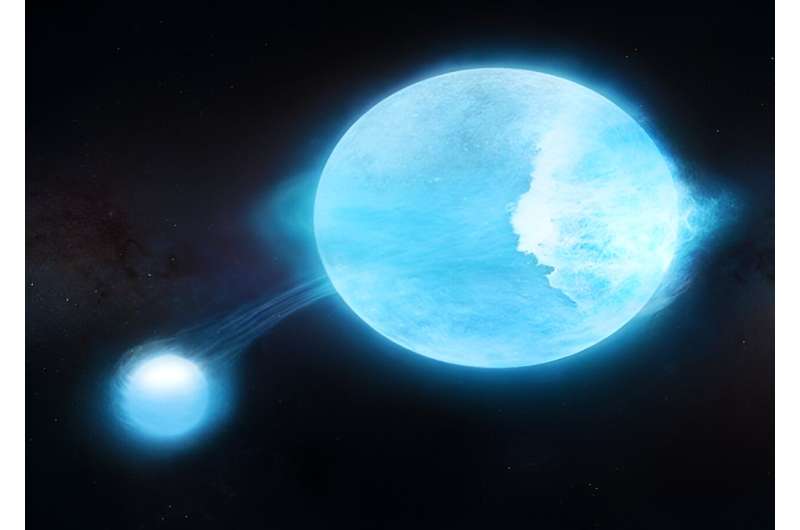This article has been reviewed according to Science X's editorial process and policies. Editors have highlighted the following attributes while ensuring the content's credibility:
fact-checked
peer-reviewed publication
trusted source
proofread
Stellar surf's up: Monster waves as tall as three suns are crashing upon a colossal star

An extreme star system is giving new meaning to the phrase "surf's up."
The star system intrigued researchers because it is the most dramatic "heartbeat star" on record. Now new models have revealed that titanic waves, generated by tides, are repeatedly breaking on one of the stars in the system—the first time this phenomenon has ever been seen on a star.
Heartbeat stars are stars in close pairs that periodically pulse in brightness, like the rhythm of a beating heart on an EKG machine. The stars in heartbeat systems loop through elongated oval orbits. Whenever they swing close together, the stars' gravities generate tides—just as the Moon creates ocean tides on Earth. The tides stretch and distort the shapes of the stars, altering the amount of starlight seen coming from them as their wide or narrow sides alternately face Earth.
A new study explains why the brightness fluctuations from one particularly extreme heartbeat star system measure some 200 times greater than typical heartbeat stars. The cause: gargantuan waves that roll across the bigger star, kicked up when its smaller companion star regularly makes close passes. These tidal waves attain such towering heights and high speeds, the study finds, that the waves break—similar to ocean waves—and crash down onto the big star's surface.
Dubbed a "heartbeat star" by astronomers, the system offers an unprecedented look at how massive stars interact.
"Each crash of the star's towering tidal waves releases enough energy to disintegrate our entire planet several hundred times over," says Morgan MacLeod, a Postdoctoral Fellow in Theoretical Astrophysics at the Center for Astrophysics | Harvard & Smithsonian (CfA) and author of a new study published in Nature Astronomy reporting the findings. "These are really big waves."
And yet, according to Professor Abraham (Avi) Loeb, MacLeod's advisor, the Director of the Institute for Theory and Computation at CfA and the paper's other author, "Breaking waves in stars are as beautiful as those on the beaches of our oceans."
Heartbeat stars were first seen when NASA's exoplanet-hunting Kepler space telescope picked out their telltale, usually subtle stellar brightness pulsations.
The extreme heartbreak star, though, is anything but subtle. The larger star in the system is nearly 35 times the mass of the Sun and, together with its smaller companion star, is officially designated MACHO 80.7443.1718—not because of any stellar brawn, but because the system's brightness changes were first recorded by the MACHO Project in the 1990s, which sought signs of dark matter in our galaxy.
Most heartbeat stars vary in brightness only by about 0.1%, but MACHO 80.7443.1718 jumped out to astronomers because of its unprecedentedly dramatic brightness swings, up and down by 20%. "We don't know of any other heartbeat star that varies this wildly," says MacLeod.
To unravel the mystery, MacLeod created a computer model of MACHO 80.7443.1718. His model captured how the interacting gravity of the two stars generates massive tides in the bigger star. The resulting tidal waves rise to about a fifth of the behemoth star's radius, which equates to waves about as tall as three Suns stacked on top of each other, or roughly 2.7 million miles high.
The simulations show that the massive waves start out as smooth and organized swells, just like ocean water waves, before curling over on themselves and breaking. As beachgoers know, powerfully crashing ocean waves launch sea spray and bubbles, leaving "a big foamy mess" where there was once a smooth wave, MacLeod says.
The tremendous energy release of the crashing waves on MACHO 80.7443.1718 has two effects, MacLeod's model shows. It spins the stellar surface faster and faster, and hurls stellar gas outward to form a rotating and glowing stellar atmosphere.
About once a month, the two stars pass each other and a fresh monster wave barrels across the heartbreak star's surface. Cumulatively, this agitation has caused the big star in MACHO 80.7443.1718 to bulge at its equator by about 50% more than at its poles. And, with each new passing wave, more material is flung outward, like "spinning pizza crust flinging off chunks of cheese and sauce" says MacLeod. The signature glow of this atmosphere was one of the key clues that waves were breaking on the star's surface, according to MacLeod.
As unprecedented as MACHO 80.7443.1718 is, it is unlikely to be unique. Of the nearly 1,000 heartbeat stars discovered so far, about 20 of them display large brightness fluctuations approaching those of the system simulated by MacLeod and Loeb. "This heartbreak star could just be the first of a growing class of astronomical objects," MacLeod says. "We're already planning a search for more heartbreak stars, looking for the glowing atmospheres flung off by their breaking waves."
All things considered, MacLeod says we are lucky to have caught the star in this phase, "We are watching a brief and transformative moment in a long stellar lifetime." And by watching the colossal surf roll across a stellar surface, astronomers hope to gain an understanding of how close interactions shape the evolution of stellar pairs.
More information: Morgan MacLeod et al, Breaking waves on the surface of the heartbeat star MACHO 80.7443.1718, Nature Astronomy (2023). DOI: 10.1038/s41550-023-02036-3
Journal information: Nature Astronomy
Provided by Harvard-Smithsonian Center for Astrophysics




















